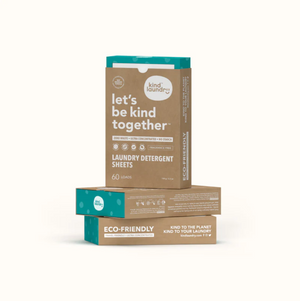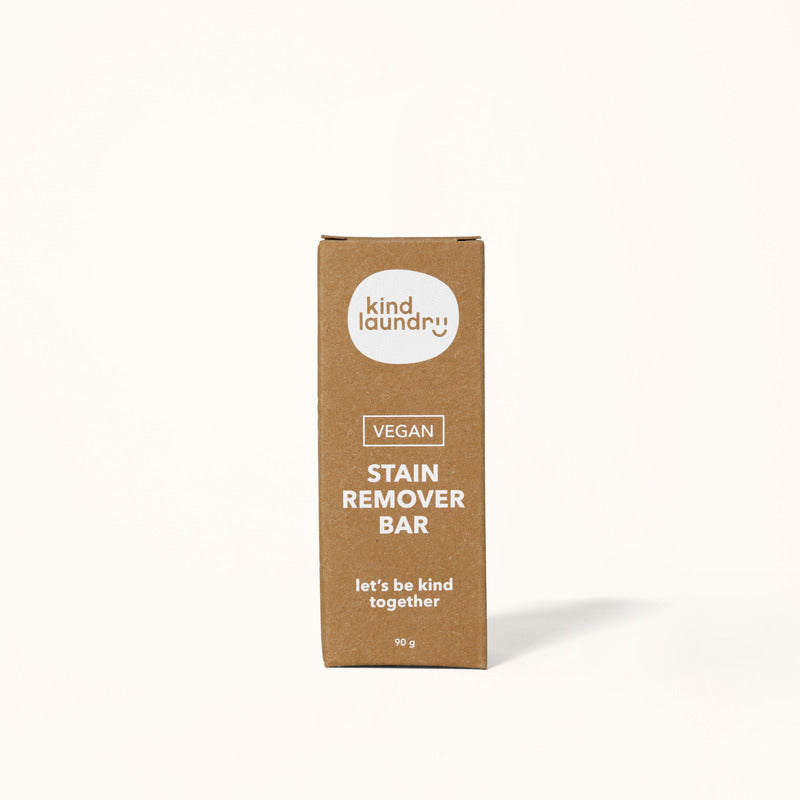When you buy new clothes, it’s good to be aware that certain types of fabrics may actually trigger a clothing allergy. An allergic reaction from clothes, known as textile contact dermatitis, can affect anyone, and can happen as a reaction to fabrics that contain chemicals and dyes that get exposed to your skin by wearing clothes.
Below we explain what textile contact dermatitis is, what causes this clothing allergy, who gets it, what the symptoms are, and how to prevent a clothing allergy.
One way to prevent clothing allergies, is to use a high quality laundry detergent that’s toxin and chemical free. Kind Laundry’s detergent sheets are made from potent enzymes and plant-based extracts. Our detergent sheets ingredients avoid harmful chemicals like parabens, phthalates, optical brighteners, dyes, phosphates, formaldehyde, 1,4 dioxane, and starch.
What is Textile Contact Dermatitis?
Textile contact dermatitis is an allergic reaction that happens on your skin, as a result of exposure to materials and chemicals in clothing fabrics.
Textile dermatitis is also known by other names, including clothing dermatitis, textile contact dermatitis, and allergic contact dermatitis. It may also be described as an allergic reaction clothes, an allergy to new clothes, or as “clothing dermatitis”.
Textile dermatitis is commonly caused by your skin coming into contact with the chemicals that are used to make clothing, such as clothing dyes, formaldehyde, flame retardants, and rough fabrics.
Many of these substances are used to manufacture clothes to give them bright colors, to reduce wrinkling or the need for ironing, and to make them non-flammable. But, these chemicals can cause a skin rash from clothes and skin irritation that can be uncomfortable.
What Causes Clothing Allergy?
It’s important to know what causes clothing allergies, so that you can avoid wearing those fabrics, especially if you’re suffering from textile dermatitis.
Some of the most common causes of clothing allergies include synthetic fibres, metallic components used to make clothes, and dyes and other chemicals used in textile manufacturing.
Not only can these substances cause skin allergies, but some are also considered as environmental pollutants that can contaminate water and soil, and ecosystems in which they land up in.
Synthetic fibers like nylon, polyester, and spandex can cause allergic skin reactions. In addition, metal components of clothing such as zippers or buttons that are made from substances like nickel may also cause textile dermatitis.
Furthermore, chemicals like azo dyes, formaldehyde, and flame retardants can irritate your skin. These chemicals are often added to create bright colors, or to make clothing fire restaurant, weatherproof, or iron-free.
There are also chemicals in certain rubbers that can cause contact dermatitis. And, certain detergents and bleach used to clean clothes can cause clothing allergies.
Symptoms of Clothing Allergy
If your skin is feeling irritated after wearing certain clothes, you may be wondering if you have a clothing allergy. It’s important that you consult a registered medical professional to make a diagnosis and to help you treat any skin allergy.
The symptoms of textile dermatitis may be similar to other conditions, so it’s important that you get proper medical advice. However, these are some of the symptoms of textile dermatitis and allergic reaction to clothing symptoms:
- Itchy skin
- dry and flaky skin
- red and inflamed skin
- skin swelling
- blisters in more serve cases
Typically, the areas of your skin that are exposed to the fabric that caused the allergic reaction, are the areas that will be red or itchy. This can happen within hours or days of contact.
Who Gets Textile Dermatitis?
Textile dermatitis can occur in anyone, although it’s more common in people who have atopic dermatitis or people with sensitive skin.
Other risk factors for developing contact dermatitis include people with less pigment in their skin, people with red hair, and people who wear fragrances and jewelry.
People who work in clothing factories and who handle a lot of textiles may also experience more textile dermatitis because of their exposure to textiles. In addition, people working as hairdressers, machinists, mechanics and agricultural workers also have a higher chance of developing allergic contact dermatitis.
That’s why it’s important to understand what causes it, so that you can prevent and manage textile dermatitis.
Clothing Dermatitis Treatment
If you suspect you may have clothing dermatitis, it’s important to seek medical advice from a registered healthcare professional for textile dermatitis treatment. They may be able to make a proper diagnosis and provide guidance for treatment and management of contact dermatitis.
Doctors can also detect what the specific cause of your dermatitis is, so that you know to avoid that specific type of fabric or chemical. However, even if you’ve identified a specific dye or chemical that’s causing your dermatitis, many clothing labels don’t specify the dyes and chemicals used to make the fabric, so it can still be tricky to avoid exposure.
Prevention of Clothing Allergy
Preventing clothing related allergies is better than having to deal with one.
There are various things you can do to avoid getting textile dermatitis, as outline below. That includes using organic detergents to wash your clothes, opting for clothes made from natural materials rather than synthetic ones, and choosing light-colored clothes that don’t have as much dyes in them as brighter clothes.
In addition, avoiding wearing clothes that require separate washing can help avoid clothes that have been dyed a lot, and avoiding clothes that say that don’t require ironing or that are dirt repellant can also help - as those clothes typically have been chemically treated.
It’s also good to take a look at what chemicals you’re adding to your clothes when you wash them. Consider the ingredients in your laundry detergent, dryer sheets, and any other fragrance boosters or softeners that you may be using.
For example, it’s best to avoid synthetic and fragranced dryer balls. Instead you can use Kind Laundry’s 100% wool dryer balls. Once you start assessing what you’re using, you may find a range of alternatives that are kinder to your skin and the planet.

Use Non-Toxic Detergents
Certain laundry detergents can trigger irritant contact dermatitis. Many contain a range of toxic chemicals that you may not even be aware of.
Using detergents that are mild, don’t contain chemicals or toxins, that are gentle on fabrics and skin can help you avoid allergic reactions on your skin.
At Kind Laundry, we’re committed being fully transparent about our product ingredients. Our laundry detergent sheets are made to be kind to the planet and your skin, by avoiding the use of harmful chemicals and dyes.
Our laundry detergent sheets are made from plant-based extracts and enzymes, and are free from parabens, phthalates, optical brighteners, dyes, phosphates, formaldehyde, 1,4 dioxane, and starch. We also provide a choice of fragrance-free laundry detergent sheets, or ocean-breeze scented laundry detergent sheets.
Our travel-size vegan stain remover bar is also chemical-free and formulated to be kind on skin. Its ingredients are: Sodium Cocoate, Sodium Palmate, Sodium Palm Kernelate, Palm Kernel Acid and Glycerine.
Choose Natural Materials
Choosing to buy and wear clothes that are made from natural fibers and textiles like cotton can also help avoid skin irritation. Organic cotton, which has been produced without synthetic fertilizers, is breathable and reduces sweating when compared with synthetic fibers like latex or polyester.
Clothes made from natural fibers often use less dyes in their manufacturing, as well as fewer chemicals, which can reduce the chances of getting an allergic reaction to fabric.
Organic hemp, organic linen, and silk are also typically made with fewer chemicals and dyes, and therefore gentler on skin. However, you may still experience a skin allergy when wearing certain natural and organic fabrics. 
Choose Light-Colored Garments
Light-colored clothes typically contain fewer dyes, which can also reduce the chances of getting an allergic skin reaction to wearing clothes.
Choosing pale and natural colors like whites, nudes, grays and pale colors - and opting for fabrics that use natural dyes may help prevent skin allergies.
Avoid Clothing Labeled “Wash Separately”
Clothes that are made to be washed separately, as indicated on the clothing label, are often made that way because they contain so much dye that it may bleed and stain your other clothes if washed together.
By avoiding clothes that have so much dye, typically dark and brightly-colored clothes, you can also help reduce the chances of a skin allergic reaction to dyes in your clothes.
Even if you’re using mild laundry detergent that’s safe for your skin, you could still experience an allergic reaction to new clothes if they contain dyes and chemicals known to trigger skin allergies.
Avoid Clothing Labeled “Non-Iron”and “Dirt Repellent”
It may be best to avoid wearing garments that have ‘non-iron’ or ‘dirt-repellant’ on the care label. That’s because those fabrics are often chemically treated, and those chemicals could potentially cause a skin allergic reaction.
Clothes labeled “non-iron”, “iron-free”, or “wrinkle-free” may actually contain formaldehyde, which is a chemical that is associated with textile contact dermatitis. The David Suzuki Foundation also says that formaldehyde “is particularly troublesome for those with chemical sensitivities”.
Clothes that are labeled “dirt repellent”, grease-repellent, stain-repellent, and water repellent are also often treated with chemicals. Instead, you may want to consider looking for clothing that contains organic textile certifications, so that you can avoid wearing fabrics that may contain harmful chemicals.
Clothing Allergy: Final Thoughts
Allergic reaction from clothes can be irritating and uncomfortable, so avoiding it in the first place can help you to keep comfortable and to protect your skin.
As textile contact dermatitis can affect anyone, it’s good to be aware of some of the most common causes, so that you can avoid those types of clothes and fabrics. That includes clothes that are heavily dyed, synthetic fabrics, and clothing made using harmful chemicals.
Remember, if you suspect textile dermatitis, it’s important to seek immediate professional medical advice to determine the cause and treat it.
Disclaimer: This website is not meant to provide medical advice on how to identify, treat or manage textile contact dermatitis. If you suspect possible textile contact dermatitis, it’s important to consult with a registered medical professional.





















